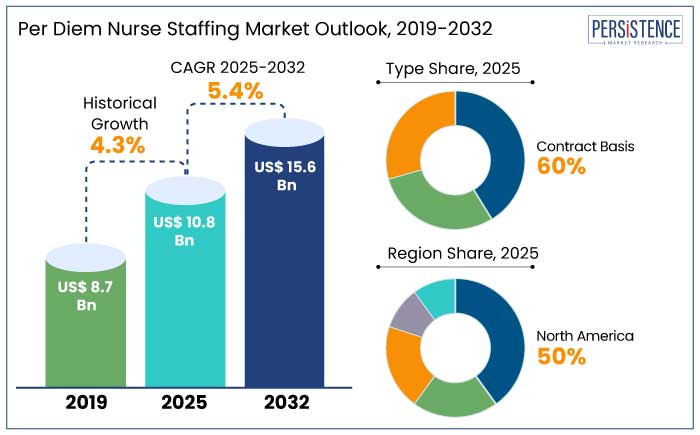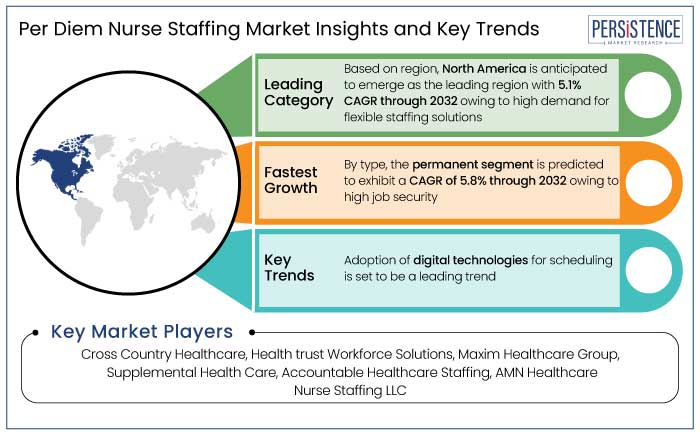Industry: Healthcare
Published Date: January-2025
Format: PPT*, PDF, EXCEL
Delivery Timelines: Contact Sales
Number of Pages: 180
Report ID: PMRREP33234
The global per diem nurse staffing market is predicted to reach a size of US$ 10.8 Bn by 2025. It is anticipated to showcase a CAGR of 5.4% during the forecast period to attain a value of US$ 15.6 Bn by 2032.
Healthcare facilities across the globe rely on per diem staffing to address sudden surges in patient volumes and staff shortages.
Digital platforms and apps are transforming the per diem nurse staffing process, thereby offering real-time matching of nurses with open shifts. Companies like ShiftMed and IntelyCare have reported user growth of over 30% annually, driven by their tech-enabled staffing models.

Key Highlights of the Industry
|
Market Attributes |
Key Insights |
|
Per Diem Nurse Staffing Market Size (2025E) |
US$ 10.8 Bn |
|
Projected Market Value (2032F) |
US$ 15.6 Bn |
|
Global Market Growth Rate (CAGR 2025 to 2032) |
5.4% |
|
Historical Market Growth Rate (CAGR 2019 to 2023) |
4.3% |
North America per diem nurse staffing market is estimated to hold a share of 50% in 2025. The region is witnessing a critical shortage of nurses owing to increasing healthcare demands and aging populations. These shortages are driving healthcare facilities to adopt flexible staffing models like per diem nursing to fill gaps without long-term commitments. For example,
North America boasts one of the most developed healthcare systems across the globe, thereby requiring dynamic staffing solutions to maintain the quality of service. High patient volumes in specialized care units and long-term care facilities are increasing demand for on-demand nurses.
Aging population significantly impacts healthcare services, increasing the demand for flexible nurse staffing. Demographic shift results in higher hospital admissions, long-term care needs, and home healthcare services, fuelling demand for per diem nurses. For instance,
Contract basis is anticipated to hold a share of 60% in 2025. Healthcare facilities require flexible staffing solutions to manage fluctuating patient volumes and seasonal demand surges. This provides temporary yet dependable nurse availability for specific durations, catering to short-term needs without long-term commitments. For instance,
Contract-based staffing decreases costs associated with recruiting, onboarding, and benefits for full-time staff. Healthcare providers prefer this model to minimize financial burdens while maintaining service quality. For instance,
Potential growth in the global per diem nurse staffing industry is predicted to be driven by the great flexibility and work-life balance offered by the employment type. This attracts younger professionals to the field. For instance,
Rising demand for home healthcare services is predicted to create new opportunities for per diem nurses in the forecast period. AI-driven platforms are set to streamline per diem nurse placements, ensuring better matching and optimized staffing solutions.

The per diem nurse staffing market growth was average at a CAGR of 4.3% during the historical period. Demand for healthcare services surged owing to the aging population and the prevalence of chronic diseases. Hospitals and clinics increasingly adopted flexible workforce models to adapt to operational challenges, including nurse absenteeism and burnout. For instance,
As the healthcare system recovers from the pandemic, the demand for per diem staffing solutions is likely to remain high to address staffing shortages and prepare for future emergencies. Aging nursing workforce and high turnover rates are likely to continue to fuel the demand for temporary staffing solutions.
Surging Cases of Nurse Shortages
A significant portion of the nursing workforce is nearing retirement age, thereby leaving critical gaps in healthcare facilities. The median age of registered nurses in the U.S. is 52 years with several estimated to leave the workforce within the next decade. For instance,
Aging global population along with the rising prevalence of chronic diseases are driving the demand for healthcare services. This further exacerbates the shortage of skilled nursing professionals.
Limited capacity in nursing education programs and faculty shortages have resulted in fewer nursing graduates entering the workforce. The pandemic places an unprecedented strain on the healthcare workforce, thereby accelerating retirements. This also prompted nurses to shift to less demanding roles or leave the profession entirely.
High Flexibility and Work-life Balance
Per diem nurses have the freedom to choose when, where, and how much they work. This flexibility accommodates their lifestyle needs, making it an attractive alternative to full-time employment. For instance,
Nurses opting for this working model can prioritize personal responsibilities, whether it’s family care, pursuing further education, or engaging in hobbies and self-care. This fosters a better mental health and overall well-being. Per diem nurses usually rotate between healthcare settings like hospitals, clinics, and long-term care facilities, keeping their work dynamic and preventing monotony. For instance,
Lack of Job Stability for Nurses
Per diem nurses are often called upon to fill staffing gaps during emergencies, seasonal demands, or sudden workforce shortages. This irregularity in work schedules can result in unpredictable income, making it difficult for nurses to plan their finances. For example,
Per diem nurses are typically not eligible for employer-sponsored benefits such as health insurance, paid time off, retirement plans, or tuition reimbursement. These benefits are critical for long-term financial stability and professional development.
Cost-effectiveness for Employers
Hiring per diem nurses eliminates the need for long-term financial commitments like salaries, benefits, retirement contributions, and paid time off. This enables healthcare facilities to allocate resources dynamically based on immediate staffing needs. For instance,
Hospitals often face increased costs due to mandatory overtime when understaffed. Employing per diem nurses enables employers to decrease the need for overtime by efficiently filling gaps.
Increasing Use of Temporary Staffing Models
Temporary staffing models enable healthcare facilities to scale their workforce up or down based on immediate needs. This is particularly critical during seasonal peaks, public health emergencies, or when patient volumes increased unexpectedly. For example,
Temporary staffing assists healthcare providers to decreases costs associated with fulltime employment, thereby improving budget flexibility. For instance,
Companies in the per diem nurse staffing market are investing in digital platforms and mobile apps to streamline recruitment, scheduling, and communication between nurses and healthcare facilities. For instance, ShiftMed and Aya Healthcare have developed mobile apps that enable nurses to select shifts that suit their schedules, offering flexibility and convenience.
Several companies are differentiating themselves by offering higher pay rates and competitive benefits to attract skilled nurses. A few companies are also providing health insurance and retirement plans for long-term per diem nurses. For instance, AMN Healthcare offers hourly pay and referral bonuses for per diem nurses, helping the company to build a large talent pool.
Recent Industry Developments
|
Attributes |
Detail |
|
Forecast Period |
2025 to 2032 |
|
Historical Data Available for |
2019 to 2023 |
|
Market Analysis |
US$ Billion for Value |
|
Key Regions Covered |
|
|
Key Market Segments Covered |
|
|
Key Companies Profiled in the Report |
|
|
Report Coverage |
|
|
Customization and Pricing |
Available upon request |
By Type
By Region
To know more about delivery timeline for this report Contact Sales

The market is anticipated to reach a value of US$ 15.6 Bn by 2032.
Contract basis type is estimated to lead with a share of 60% in 2025.
North America is anticipated to emerge as the leading region with a share of 50% in 2025.
Prominent players in the market include Cross Country Healthcare, Health trust Workforce Solutions, and Maxim Healthcare Group.
The market is predicted to witness a CAGR of 5.4% throughout the forecast period.